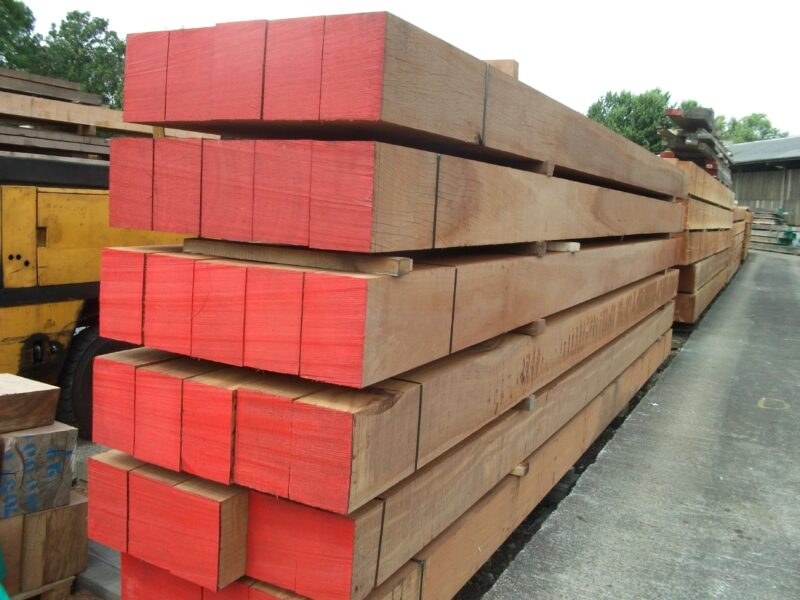Why use Ekki timber?
Published: 31/01/19 By: Mike Bekin
Ekki is one of the main species of timber that we sell here at EcoChoice.
Also known as Azobe or Bongossi (or by its Latin name, Lophira Alata), it is a tropical hardwood that mainly grows in the swamps and rainforests on the cost of West Africa, in countries such as Sierra Leone, Nigeria and Cameroon.
The tree itself grows to be quite large, about 100-150 feet tall (between 30 and 46m), and the diameter of the trunk is around 5-6 feet (1.5-1.8 metres), so is generally available in large sizes.
Appearance
Ekki is also sometimes called Red Ironwood, due to it being an extremely strong species of timber, and because of its red colour, which you can clearly see in the photo with this article. The sapwood is more of a pink colour, whereas the heartwood is a dark red or violet brown. Apart from the colour of the wood, it is also quite recognisable for having a speckled appearance, as the pores contain light-coloured (white and yellow) mineral deposits which make streaks throughout the wood.
Strength and Durability
Ekki is well known for being incredibly strong (strength class D70), heavy, hard and naturally durable (durability class 1), rather than for any aesthetically pleasing properties. In fact, it is generally considered to be the most durable of all African woods. It weighs on average 65 pounds per cubic foot – which means it is part of a very small group of timber species which will sink in water. In comparison, oak has an average weight of 47 pounds per cubic foot. Its grains are interlocked rather than all aligned in the same direction, which make it incredibly hard to split, making it a perfect option for fenders in rivers, canals, docks and harbours.
It is naturally resistant to both insect and fungal attack, and to weathering, meaning that you don’t have to use toxic chemicals to protect it, and it is known for having a good finishing surface.
Downsides of using Ekki
The only downsides that are often mentioned to Ekki is that it can be difficult to work because it is so strong and hard, and that it takes a long time to dry, so it can distort in the process. It is particularly difficult to work if just using hand tools, but it can be worked by sharp tools and good quality machines, although it needs to be pre-drilled before nailing. The fact that it is so long lasting and durable mean that it is worth the effort involved to work it.
Uses of Ekki
Because it is so strong, hard and durable, Ekki is quite often the timber of choice for heavy construction projects and for marine projects. In particular, it is ideal for using to build bridges, decking, piling, fenders and lock gates. It is also often used for flooring, with its durability making it ideal for areas where the flooring gets a great deal of footfall such as large ship decks. It is also ideal for other uses in construction where heavy, durable timber is required, and for railway sleepers.
Sustainability
Ekki is considered to be a vulnerable tree because it has been exploited over the last three generations. As we noted earlier in the article, it grows in developing countries in West Africa where there has been a history of deforestation. Illegal deforestation often goes hand in hand with corrupt practices, human rights abuses, hunting endangered animals and the destruction of habitats. Because of this, it is particularly important to source Ekki timber from independently certified sustainable sources, such as FSC certified forests.
FSC stands for Forest Stewardship Council. The FSC is an independent, not for profit organisation that exists in order to promote responsible management of the world’s rainforests. In other words, they ensure that the wood they certify comes from sustainably managed forests, not from illegal logging. The FSC certification system is recognised around the world.
All of the tropical hardwood timber that we use is sustainable and comes from FSC sources. You may be thinking that all this does is do less damage to the forest than illegal deforestation does, and that is a common misunderstanding, but sourcing timber for an FSC forest doesn’t just do less damage to the forest, it actually helps the forest.
The FSC selects and cuts trees in a way that respects the forest and ensures that the forest is there for future generations. They make sure that no damage is done to the environment, people and the wildlife that live in it, and the purchasing of FSC certified timber helps the FSC forests to remain economically viable and allows the FSC to continue protecting them.
Interesting Fact
Sniffing the bark of the Ekki tree is used as a traditional method of treating headaches, so even though this is a species of timber not to be sniffed at, at the same time is a type of tree to quite literally be sniffed at!
Who are EcoChoice?
EcoChoice are specialist suppliers of certified timber and recycled plastic products for exterior works: from cladding and decking to piers and footbridges. We were formed in 2005 with the aim of promoting FSC certified timbers to the UK construction industry, helping customers to engage in a sustainable way instead of turning away from both the deforestation and plastic waste problems. In addition to Ekki, we also offer products from a wide range of other different timber species.
We are passionate about supplying our clients with independently certified timber products while encouraging responsible and sustainable practices at the source level. To find out how we can help you and to get a quick, no-obligation quote, please call us on 0345 638 1340, email us on info@ecochoice.co.uk or for more information about our sustainable timber products, please visit our website https://ecochoice.co.uk/
